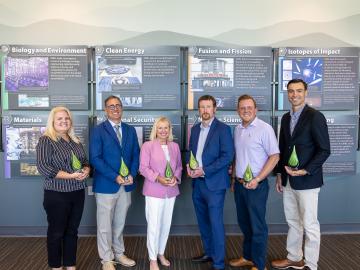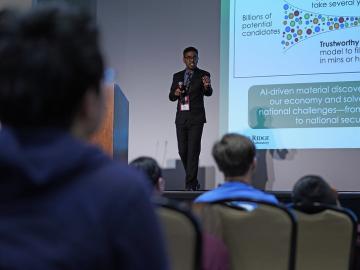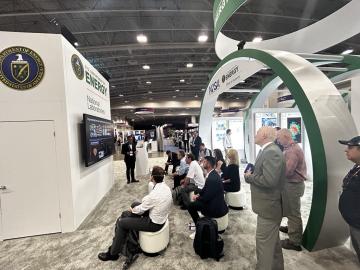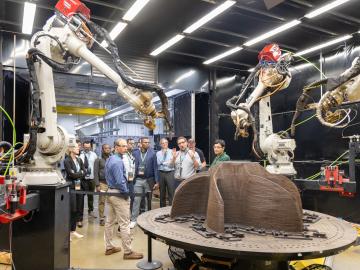
Filter News
Area of Research
- Biology and Environment (17)
- Computational Biology (1)
- Computer Science (1)
- Electricity and Smart Grid (2)
- Energy Science (30)
- Functional Materials for Energy (1)
- Fusion and Fission (25)
- Fusion Energy (4)
- Isotopes (5)
- Materials (24)
- Materials for Computing (1)
- National Security (16)
- Neutron Science (9)
- Nuclear Science and Technology (19)
- Supercomputing (32)
News Type
News Topics
- (-) Artificial Intelligence (85)
- (-) Clean Water (16)
- (-) Grid (35)
- (-) Nuclear Energy (79)
- (-) Partnerships (42)
- (-) Security (19)
- (-) Space Exploration (14)
- 3-D Printing/Advanced Manufacturing (73)
- Advanced Reactors (17)
- Big Data (49)
- Bioenergy (74)
- Biology (86)
- Biomedical (46)
- Biotechnology (25)
- Buildings (37)
- Chemical Sciences (46)
- Composites (15)
- Computer Science (127)
- Coronavirus (23)
- Critical Materials (6)
- Cybersecurity (20)
- Education (2)
- Emergency (3)
- Energy Storage (47)
- Environment (130)
- Exascale Computing (53)
- Fossil Energy (6)
- Frontier (47)
- Fusion (47)
- High-Performance Computing (92)
- Hydropower (6)
- Irradiation (1)
- Isotopes (41)
- ITER (5)
- Machine Learning (39)
- Materials (82)
- Materials Science (75)
- Mathematics (8)
- Mercury (7)
- Microelectronics (3)
- Microscopy (31)
- Molten Salt (3)
- Nanotechnology (29)
- National Security (67)
- Neutron Science (95)
- Physics (40)
- Polymers (14)
- Quantum Computing (37)
- Quantum Science (52)
- Simulation (46)
- Software (1)
- Statistics (2)
- Summit (42)
- Transportation (41)
Media Contacts

Advanced materials research to enable energy-efficient, cost-competitive and environmentally friendly technologies for the United States and Japan is the goal of a memorandum of understanding, or MOU, between the Department of Energy’s Oak Ridge National Laboratory and Japan’s National Institute of Materials Science.

Andrew Conant from ORNL's nuclear nonproliferation division is collaborating with national laboratories to analyze isotopes generated in nuclear reactors. This research aims to glean insights into the operations and objectives of these reactors. ORNL, renowned for its leadership in nuclear research, maintains its legacy by promoting the peaceful utilization of nuclear energy worldwide.

In May, the Department of Energy’s Oak Ridge and Brookhaven national laboratories co-hosted the 15th annual International Particle Accelerator Conference, or IPAC, at the Music City Center in Nashville, Tennessee.

Six firms received Small Business Awards from the Department of Energy’s Oak Ridge National Laboratory. The companies, selected from small business service providers to the lab, were recognized by ORNL's Small Business Programs Office for their specific capabilities and contributions.

Phani Ratna Vanamali Marthi, an R&D associate in the Power Systems Resilience group at ORNL, has been elevated to the grade of senior member of the Institute of Electrical and Electronics Engineers, the world’s largest technical professional

Prasanna Balaprakash, a national leader in artificial intelligence, or AI, spoke to some of the highest achieving students in the country at the National Science Bowl in Washington D.C.

ORNL researchers and communications specialists took part in the inaugural AI Expo for National Competitiveness in Washington D.C, May 7 and 8, to showcase and provide insight into how the lab is leading the way for utilizing the vast possibilities of AI.

John Lagergren, a staff scientist in Oak Ridge National Laboratory’s Plant Systems Biology group, is using his expertise in applied math and machine learning to develop neural networks to quickly analyze the vast amounts of data on plant traits amassed at ORNL’s Advanced Plant Phenotyping Laboratory.

Momentum for manufacturing innovation in the United States got a boost during the inaugural MDF Innovation Days, held recently at the U.S. Department of Energy Manufacturing Demonstration Facility at Oak Ridge National Laboratory.

Researchers set a new benchmark for future experiments making materials in space rather than for space. They discovered that many kinds of glass have similar atomic structure and arrangements and can successfully be made in space. Scientists from nine institutions in government, academia and industry participated in this 5-year study.


